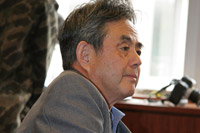Seishi OZAKU
What is Print Art?
What is print art? For me, as a print artist, that is a question that I am always thinking about. I am afraid that in such a time as this, flooded with printed matter, unless we find a ground for insisting that this is a print, and not usual printed matter, we will lose the reason that we continue printmaking activity. Thus, I would like to start this brief text by bringing up my opinion that an ukiyo-e print is not “hanga.”
It is said that Kanae Yamamoto (1882-1946) and others, who started the Sosaku-hanga movement, were the first to use the word “hanga.” They applied the word to printed art created with a production system different from that of ukiyo-e. Ukiyo-e was a product of division of labor by plural artisans -- a publisher commissioned an ukiyo-e designer, a carver and printer made the ukiyo-e based on the design, and then the publisher sold the product on market. The word “hanga” was originally expected to be used in reference to something different from the traditional ukiyo-e by putting the process into an individual dimension. But, since the Japanese word “hanga” was very appropriate as a name exactly for “simply printed matter” or ”full-color matter,” it was applied to nishiki-e (full-color woodblock). Actually, our senior print artists, who underwent the baptism of European modern painting, declared that a print, as totally a personal expressive medium, will not be completed without going through the process in which they get an image they like, prepare the plate for printing, and transfer the image onto a sheet. In this way, they started to develop a new print movement called “Sosaku-hanga.”
Western modern painting, as a personal expressive medium, started at a point of time when oil painting, run off the authority of church or royalty, was no longer wanted by them. I suppose that just like modern painting, the Sosaku-hang movement, too, started ironically at a point of time when woodblock prints, copper prints, or later lithography had no more use for society, in spite that these media once had shouldered responsibility for a printing revolution, changed society, and made a contribution to development of the community.
I can confidently say that to believe that “what was no longer wanted” will actually contain something precious leading to a humanistic element should be our basic attitude for art.
Thinking of the fact that print artists obtained an expressive freedom because those print media were no longer wanted, we can liberate ourselves from the press machine, and should realize again that we humans are animals who have two eyes, departing from a camera-wise outlook of the world: to turn our back on the current progress of technology is even a possible important choice as a proper attitude for print-making.
Based on those ideas, I judged the entries for this triennial exhibition. I selected two pieces by Veronique DENIEUIL (France), SHIMIZU Masahisa (Japan) as jury awards, recognizing their simple feel of handwork and an opposite air against the contemporary mass-production and speed-first society.
